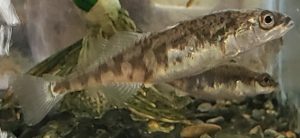In the late 20thcentury, a popular science communicator named Stephen Jay Gould asked a deceptively simple question:
If we turned back the tape of life to the very beginning and allowed it to repeat from the beginning, would we arrive at a similar endpoint?
In other words, how predictable and repeatable is evolution, and to what extent do evolutionary outcomes depend on random processes? Many scientists have since suggested that the answer to Gould’s thought experiment may depend largely on the scale at which we examine the question – if we wind the tape back 10,000 years, we may see more repeatability than if we wind the tape back 1.5 million years. Addressing this complexity may take us one step closer to being able to predict future evolutionary events, yet little research has truly addressed whether scale matters in evolutionary repeatability. Recent work by Antoine Paccard and colleagues published in the Journal of Heredity using a common evolutionary model system, the threespine stickleback, provides some evidence that scale does in fact matter to evolutionary repeatability.

Threespine stickleback are a small fish found in aquatic habitats all across the Northern Hemisphere (Fig 1). They represent a classic case of adaptive radiation, in which a single ancestral population repeatedly gives rise to daughter lineages that exhibit natural variation in many traits (Fig 2). In the case of the stickleback adaptive radiation, fish rapidly and repeatedly colonized freshwater habitats as those habitats opened up during the last deglaciation period, approximately 10-12,000 years ago and have since adapted to their new habitats in a variety of ways. This adaptive radiation is unique because an ancestral proxy population still survives today in the form of marine stickleback populations. Marine stickleback are geographically similar across the global, and historically consistent to fish found in the fossil record. This consistency allows us to use them to infer the direction of evolution in a way we cannot without knowing what the ancestral form may have looked like. Given their establishment as a model system for evolutionary and developmental studies, scientists have worked to develop critical genetic tools to further help us link natural evolutionary processes with their underlying genetic architecture. In the current study, Paccard and colleagues made use of these tools to tackle a new question – just how repeatable is evolution in this adaptive radiation?

Paccard and colleagues (2020) examined a number of lake-stream population pairs, where stickleback reside both in a lake and its adjoining stream inlet or outlet. Six of these pairs were located in various habitats on Vancouver Island, while another six pairs were taken from the Haida Gwaii, Ireland, and Germany. Stickleback in lakes and streams diverge in consistent and predictable ways in independent water sheds; lake fish tend to be shallower bodied, with fewer gill rakers, than their stream counterparts, a difference largely due to the difference in available prey across these habitats (Fig 3). The authors examined a suite of characters known from previous work to diverge between lake and stream habitats, and looked at whether fish from lakes in the same general geographic region were more similar to each other than fish from lakes spread across wide geographic areas. They did the same with the fish in the streams.

Overall, they showed that there is significantly more parallelism within a geographic region than between it (Fig 4). This was true when considering a number of traits all together (Fig 4), as well as when looking at each trait individually. The researchers also looked at genetic diversity between population pairs, both for genes that were likely involved in the trait divergence as well as at presumably neutral genetic markers. They found that the genes likely to be under selection exhibited more parallelism at the regional scale than the global scale, but that the neutral markers exhibited similar levels of parallelism across scales. This is an important finding because it suggests that the higher levels of parallelism in the regional population pairs are not simply due to a closer genetic relationship between population pairs at a regional scale. Rather, the authors suggest that the higher levels of parallelism in the regional population pairs are probably due to a higher degree of environmental similarity at a regional scale than at a global scale. Two lakes on Vancouver Island are likely more similar to each other than a lake in Germany is to a lake in the Haida Gwaii. Ultimately, this work has important implications for those who study evolution in the hopes of being able to predict how natural populations might respond to future events; it will be extremely important for those scientists to consider the impact of scale.

References

Dr. Dina Navon is a postdoctoral fellow currently working in the Higham lab on the genetic basis of complex feeding behavior using threespine stickleback as a model system.




